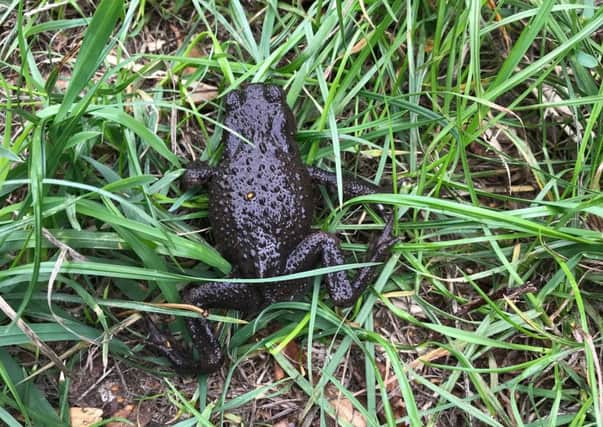Toad in a '˜hole' lot of trouble!


The warted wandered had fallen into a drain on Moor Lane, Branston, on Friday August 17 and was spotted by a passerby at around 9pm.
They happened to glance down into the drain and saw the amphibian struggling in the oily, dirty water, and called the RSPCA for help straight away.
Advertisement
Hide AdAdvertisement
Hide AdChief Inspector Becky Lowe headed out to help the critter. After lifting up the drain cover she carefully scooped the toad out with a net, checked him for any signs of injury, before releasing him into some grassland nearby.


She said: “In my job at the RSPCA I’m used to helping all sorts of animals from pets, farm animals, horses and wildlife, and every animal’s life is just as important.
“It’s not uncommon for toads and frogs to accidentally fall into drains on the road, but it could have been a sad ending for this toad had he not been spotted and we hadn’t been called to help.
“It’s really heartening to think that people are kind enough to look out for our amazing wildlife and call for help when it’s needed.
Advertisement
Hide AdAdvertisement
Hide Ad“Just a few minutes was all it took to help him out and release him. We’re really grateful to all the people who call us to report animals in need, and it’s a really great feeling to release wildlife back into the wild.”
The common frog and the common toad are found throughout Britain.
The natterjack toad is now rare and fully protected by law and is mainly confined to some coastal sand dunes and lowland heaths.
What’s the difference between frogs and toads?
Common frogs:
• have smooth, moist skin which is not slimy
• have special glands to keep the skin moist and supple - this helps them to ‘breathe’ through their skin as well as their lungs so that they can stay underwater for a long time
• are mottled shades of green, yellow or brown
• have a distinct brown patch behind the eye
• move in springy leaps
• lay spawn in clumps
Common toads:
Advertisement
Hide AdAdvertisement
Hide Ad• have a dry, warty skin which means they can’t ‘breathe’ through their skin as well as frogs, but they can survive on land in drier places
• are usually grey-brown
• crawl rather than hop
• lay long, double row, strings of eggs.
Natterjack toads:
• have a yellow stripe down their back
• often run quite fast
• lay long, single row, strings of eggs.
A gardener’s friend?
Both frogs and toads eat a lot of beetles, bugs and woodlice, and frogs will eat a large number of slugs and snails, whereas toads favour ants.
Don’t be surprised if frogs or toads are found in greenhouses. They are attracted there by the warm, moist conditions and will live in a greenhouse quite happily, eating the insects and other small creatures that live there too.
Annual migration of toads to breeding sites
Each spring, toads may be seen migrating in large groups and over distances of a kilometre or more to return to their pond to breed. At this time, toads are vulnerable when crossing roads, with many being squashed by cars.
To help the RSPCA continue to rescue and care for our amazing wildlife, you can make a donation by visiting www.rspca.org.uk/give.